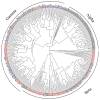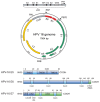Update on the Epidemiological Features and Clinical Implications of Human Papillomavirus Infection (HPV) and Human Immunodeficiency Virus (HIV) Coinfection
- PMID: 35630489
- PMCID: PMC9147826
- DOI: 10.3390/microorganisms10051047
Update on the Epidemiological Features and Clinical Implications of Human Papillomavirus Infection (HPV) and Human Immunodeficiency Virus (HIV) Coinfection
Abstract
Human papillomavirus (HPV) infection is the most common sexually transmitted infection (STI) worldwide. Although most HPV infections will spontaneously resolve, a considerable proportion of them will persist, increasing the risk of anogenital dysplasia, especially within certain populations, such as patients infected with human immunodeficiency virus (HIV). Furthermore, high-risk oncogenic HPV types (HR-HPV) are the main cause of cervix and other anogenital cancers, such as cancer of the vagina, vulva, penis, or anus. HIV and HPV coinfection is common among people living with HIV (PLWH) but disproportionally affects men who have sex with men (MSM) for whom the rate of persistent HPV infection and reinfection is noteworthy. The molecular interactions between HIV and HPV, as well as the interplay between both viruses and the immune system, are increasingly being understood. The immune dysfunction induced by HIV infection impairs the rate of HPV clearance and increases its oncogenic risk. Despite the availability of effective antiretroviral therapy (ART), the incidence of several HPV-related cancers is higher in PLWH, and the burden of persistent HPV-related disease has become a significant concern in an aging HIV population. Several public health strategies have been developed to reduce the transmission of HIV and HPV and mitigate the consequences of this type of coinfection. Universal HPV vaccination is the most effective preventive tool to reduce the incidence of HPV disease. In addition, screening programs for HPV-related cervical and vulvovaginal diseases in women are well-recognized strategies to prevent cervical cancer. Similarly, anal dysplasia screening programs are being implemented worldwide for the prevention of anal cancer among PLWH. Herein, the main epidemiological features and clinical implications of HIV and HPV coinfection are reviewed, focusing mainly on the relationship between HIV immune status and HPV-related diseases and the current strategies used to reduce the burden of HPV-related disease.
Keywords: anal cancer; cervix cancer; coinfection; human immunodeficiency virus (HIV); human papillomavirus (HPV); screening.
Conflict of interest statement
Edward Cachay received unrestricted grant funding support from Gilead Sciences and Merck Sharp and Dohme paid for the reagents used at the University of California. Additionally, advisory Board of Theratechnologies. The other authors have no potential competing interests to declare.
Figures






References
Publication types
Grants and funding
LinkOut - more resources
Full Text Sources
Medical

